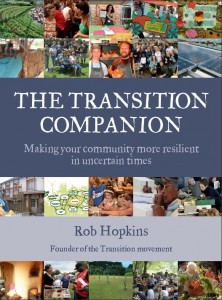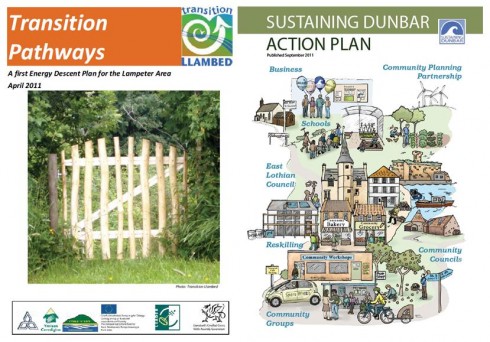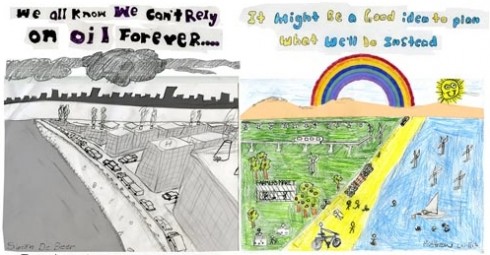15 Mar 2012
Reflections on Energy Descent Action Plans: a response to Vera Bradova
 A fascinating post over at Leaving Babylon by Vera Bradova called Tedium and black magic: the trouble with Energy Descent Action Plans (EDAPs) raises some interesting questions about Transition and planning, and EDAPs in particular. The version published at EnergyBulletin.net pulls out some of the most salient comments. It offers a very good opportunity to revisit the role of the EDAP in Transition, and how that has changed over time, an issue I am very grateful to her for raising.
A fascinating post over at Leaving Babylon by Vera Bradova called Tedium and black magic: the trouble with Energy Descent Action Plans (EDAPs) raises some interesting questions about Transition and planning, and EDAPs in particular. The version published at EnergyBulletin.net pulls out some of the most salient comments. It offers a very good opportunity to revisit the role of the EDAP in Transition, and how that has changed over time, an issue I am very grateful to her for raising.
At the heart of Bradova’s article is a sense that EDAPs represent a rigid planning for the future, akin to the planners of the 1950s who planned, and then executed, their big bold vision for post-war cities, even when it began to become clear that there were flaws in what they were doing. She argues that Transition “went whole hog for planning”, and that this became the principal raison d’etre for Transition groups. This is absolutely not my experience, as I hope to explore here.
 Her article raises several important issues I think. The first is that, as she acknowledges, she has yet to read ‘The Transition Companion’, the latest setting out of Transition. The Companion is a complete revision of how Transition is presented, a sea change from the Handbook. Much of her critique is based on the assumption that creating an EDAP is the objective of a Transition group, as presented in the Handbook.
Her article raises several important issues I think. The first is that, as she acknowledges, she has yet to read ‘The Transition Companion’, the latest setting out of Transition. The Companion is a complete revision of how Transition is presented, a sea change from the Handbook. Much of her critique is based on the assumption that creating an EDAP is the objective of a Transition group, as presented in the Handbook.
The Companion takes a very different approach, arguing that an EDAP is but one of many ingredients that an initiative can pick up and do if it feels it would be useful (see that ingredient here). Clearly for many Transition initiatives on the ground it doesn’t feel like a useful thing to put time into, given that 6 years into Transition you can count the number of completed EDAPs on one hand. That’s not to say though that the entire concept of applying some intentional design to the challenges we face is of no value.
The original idea behind EDAPs was that the scale of what we need to do (reconfigure the places we live for a post peak money, peak oil, climate responsible world) is such, and the resources available for us to do it so small, and decreasing, that we need to think carefully about the best way to apply our energy and available resources to making it happen. It is, in effect, a design project, rather than a planning project. Here is a short film, that was an extra on the DVD of ‘In Transition 2.0’, about the Totnes EDAP process which gives a sense of the project and the spirit of it:
What Transition tries to bring to the debates around how we move to a more sustainable world is the suggestion that while it is great to start doing loads of projects, and as Vera argues, Incredible Edible Todmorden is a wonderful example of that, it is also important to think about how the initiatives you kick off can build together in a more strategic way. This doesn’t mean some Stalinist-style central planning approach, but can mean an element of intentional design. Vera quotes Lewis Mumford in order to show a healthier approach to planning, but actually gives a more accurate description of how Transition initiatives are already approaches planning for the future:
“Organic planning does not begin with a preconceived goal: it moves from need to need, from opportunity to opportunity, in a series of adaptations that themselves become increasingly coherent and purposeful so that they generate a complex, final design, hardly less unified than a pre-formed geometric pattern. Towns like Siena illustrate this process to perfection.”
This feels to me to far better represent what Transition does than the rigid approach Vera attributes to it. Permaculture design has long been one of the original foundations of Transition, and it takes an approach to design which isn’t rigid in the way she describes. As a permaculture teacher I would teach people that the design process had the following steps, known as OBREDIM:
- Observation
- Boundaries
- Resources
- Evaluation
- Design
- Implementation
- Maintenance.
I also taught it as OBREDIMET, adding Evaluation and Tweaking onto the end, the idea that it is constantly being reviewed and adjusted. It is this kind of active learning and ongoing reflection that is at the heart of an EDAP.
Vera writes in one of her comments in the thread that “I am not against strategic thinking per se; I am against strategic thinking as a big preamble to doing”, but this is really a misunderstanding of Transition. Strategic thinking is never seen, or presented, as “a big preamble to doing”. There is a huge amount to be said for just getting started and doing stuff, indeed it is what most initiatives do. There is certainly no sense that they have to have done huge amounts of planning before they can plant a tree, forming groups, organise events, or whatever. Hopefully yesterday’s post gave a sense of how important it is to just get started and start making things happen.
What we are seeing emerging from this global experiment that is Transition is a range of approaches. Transition Town Brixton is a great example of a project-led initiative. All kinds of projects have emerged, the Brixton Pound, Brixton Energy, food growing projects and so on, and as they emerge they support each other and work together as strategically as possible. They have thought about, and decided against, doing an EDAP, preferring instead to drive forward on projects.
In Totnes, from Day 1 there have been numerous projects underway, and the EDAP ran alongside those, rather than everything being put on hold for 18 months while the EDAP was created. The EDAP helped to identify a number of key initiatives, and a clear narrative, as well as some very useful and dynamic pieces of research. Now a lot of new things are emerging, enterprises, projects, but they are seen as part of a coherent and well-connected narrative.
Transition Norwich started with a number of projects, and then a few people who felt qualified and enthused to do so undertook a piece of research called ‘Can Norwich Feed Itself?’ which did some strategic thinking about how the localisation of food in the area might happen and what new infrastructure this would require. This identified a number of key initiatives, some of which are now underway. The key points here are firstly that strategic planning can come at any stage of the process, and secondly that Transition only works because it creates a space in which people can drive forward what they are passionate about. It is, in this sense, a ‘do-ocracy’, that its evolution and stages are shaped by the people who are doing stuff.
If there is a group of people who are fired up about the idea of creating an EDAP, then it’ll happen and will become a useful focus for the group. It needn’t be a huge document in order to be useful, as the Dunbar EDAP (see right, above) demonstrated. If no-one wants to do it, it won’t happen, and that’s fine too. As energy builds from the projects and the impact they are having, it is likely that discussions will start to emerge about how they might be seen in an more strategic context, hence the ingredient on Strategic Thinking appearing in Stage 4 of Transition in the Transition Companion. It is important to restate here that no-one knows how to do this, which approaches are best. It is for the initiatives themselves to figure this out, to develop tools that work for them, not for me, not for Transition Network.
This approach, with its complexities, its self organisational nature, its trust in the process, is entirely different to a well funded, centrally-driven planning process. Vera’s criticisms also assume that Transition could, even if it wanted to, wield the kind of power that those sort of plans do. This is, unfortunately, nowhere near being the case. An EDAP, or any kind of strategic design process, is more about changing the story, changing the narrative, showing what’s possible, setting out how we could get to where we want to go, but not how we will get there. I think that is a hugely valuable thing to do. The Totnes EDAP was more of an Energy Descent invitation than a plan in the more rigid sense, as Michelle Colussi identified in her review of it:
In short, as impressive a document as Transition In Action is, it falls short of being an Energy Descent Action Plan. Instead, it seems to be more of a vision – a remarkably explicit, exciting, and community-based vision that tells us exactly what is to come about, but not how or by whom. Ultimately, the document acts like more of an Energy Descent Invitation, than a Plan.
This is part of the thinking that underpins an EDAP, that it is about creating a new story, giving a sense of the most strategic next steps to take, but always doing so in a way that thinks on its toes, adapts, is flexible and sees any EDAP as a narrative which sustains the projects that are emerging, rather than constraining them. In his comments, Energy Bulletin’s Bart Anderson quotes from John Thackara’s recent review of ‘The Transition Companion’:
“One of the many virtues of this awesome and joysome book is that the word “strategic” does not appear until page 272; a section on “policies” has to wait until page 281. It’s not that the book is hostile to high altitude thinking; on the contrary, its pages are scattered with philosophical asides on everything from Buddhist thinking and backcasting, to time banking and thermodynamics. But the rational and the abstract are given their proper, modest, place.”
A different approach underway in Totnes, Hereford and Manchester as part of the REconomy project, and which could yet prove more useful than the EDAP, is the Economic Blueprint. This isn’t so much a plan as an analysis of the local economy, which enables a clear understanding of the local economy, where money is spent, how much goes through local businesses and how much not, to enable to economic case for Transition to be made in a compelling way. It allows, if you like, the ‘size of the prize’ to be measured. It is a process that is harder to do as the kind of collective community visioning process outlined in the Totnes EDAP film above, being a fairly complex piece of research, but as a way of laying the foundations for the emergence of a new economy, and for arguing the case for that as powerfully as possible, it may prove more effective.
So, to wrap up, I think that if Vera were to read ‘The Transition Companion’ she’d be pleasantly surprised. An EDAP is presented as one ingredient of many that a Transition initiative may choose to adopt as they create what they feel is the most effective path towards resilience. It is never presented as an alternative to action, to projects. The idea is to embody, somehow, the need for thinking strategically about how the emerging strands of Transition, as well as what already exists in the place, can best weave together to make Transition happen. Exactly what that looks like will be different in every place, dependent on its culture, its interests, its passions and it skills. The beauty of a network such as Transition though is that it enables the learnings as we figure it out to be shared as widely and as rapidly as possible.



John Mason
15 Mar 4:19pm
I read both pieces with interest. I can see where she is coming from and at the same time I can see that there exists a misperception about Transition, the best antidote to which is the old ‘let it go where it wants to’ meme. Of course it must, does and will evolve as circumstances change through time, planned responses to the situation today being different to planned responses to the situation in five, ten or twenty years. We really have no hard idea as to what the situation will be like at any of these points because there are too many completely unpredictable variables in the mix.
For me, planning is about strategy. I’ll give an example: sea-fishing. A few times every year some friends and I drive up to a deep, rocky section of the North Wales coast. It fishes very well in the right conditions so that a stone of fish per person is possible, which can be cut up and frozen down (or salted once I figure out how to do that). The key words are ‘right conditions’.
So the planning is not the BAU version of consulting the diary and looking for a clear slot. Instead it involves checking forecast models, not just weather but tides (size/timing), sea swell, sea temperatures etc. Weather needs to be settled to make the trip safe, but it’s no good going in settled weather three days after a gale because the water will still be cloudy and the fish won’t see the lures so well and it will be a waste of fuel going there, something that will become even more pressing as the years go by. So, like a permaculturist growing stuff, we work with nature and plan our activity by nature first and foremost. I firmly believe that learning how to do that is the most important aspect of success in not only fishing but in many other activities. Quite different to the version of planning in Vera’s piece!
Cheers – John
Hans Noeldner
15 Mar 6:21pm
I found Vera’s piece to be much more applicable to the attitudes of New Urbanists. Having attended a Congress (CNU 19), it struck me that the narrative “behavior follows design” still reins supreme among them. But then what would one expect from members of a profession which tends to attract a highly disproportionate share of people with god-like aspirations to control?
Mary Saunders
15 Mar 9:08pm
Re-Inventing Fire, Amory Lovins, states that efficiency will happen because it has to happen for business reasons. It seems to have been carefully constructed so as to weather intense scrutiny. The only reason I have to be a bit skeptical is that the Lovinses are wired in with the power elites. Still, there is no arguing with the Colorado house, which was net-plus last I checked.
Miguel Leal
16 Mar 12:18pm
One great article that reminds us of what Transition is about and not.
It was a sort of getting back to the roots.
Thank you Rob, it was a great reading!
vera
16 Mar 9:03pm
I am delighted with your response, Rob, and I am already on my way, getting the Transition Companion! Can’t wait.
What prompted my post was in part my examination of the two latest EDAPs coming down the pike, and realizing, to my consternation, that these were indeed merely EDAP invitations, with more plans to follow. I believe it was Dunbar who proudly announced that they already got a grant to develop the new action plan out of the EDActionPlan. Huh? And then they encourage all the groups working on subtopics like Food or Transport to develop their own sub action plans! I thought, does the madness never end?!
I am delighted that such excesses turn out to be the exception rather than the rule, and that TTM has progressed to include the fantastic ideas of Christopher Alexander. I share your belief that this is indeed the path to forge, and I am so pleased that Transition is one of the groups around the world working to incorporate Alexander’s insights into the way they do things. I am only impatient to see more! 🙂 I think we do need guidance on the journey; let us learn from mama nature’s way of doing things. She does not plan; she evolves. Alexander speaks of generative codes and sequences. I just wrote another post within my unplanning series called Permadesign that touches on nature’s way of designing, and hope to find other co-conspirators thereby. 😉 See it here:
http://leavingbabylon.wordpress.com/2012/03/11/permadesign/
I have been struggling with what “strategic thinking” might mean. Surely we need something like that, but I remain leery of the “strategic thinking package” that carries too much odor of corporatism and militarism. Clearly, we need guidance, we need new stories, we need to show what is possible (without assuming that this is what *will* happen). And at the same time, we have to be on the watch for ways of thinking and doing that subtly lead back to the same cul-de-sacs we have worked so hard to emerge from. I am delighted that in my exploration of these issues, I am in such good and thoughtful company.
Bart Anderson
16 Mar 9:22pm
Thanks, Rob, an excellent clarification.
Doly
14 Apr 6:37pm
“If there is a group of people who are fired up about the idea of creating an EDAP, then it’ll happen and will become a useful focus for the group. It needn’t be a huge document in order to be useful, as the Dunbar EDAP (see right, above) demonstrated.”
Nice to know you think this, Rob. This is about the same answer that I got from Shaun Chamberlin when I asked about the same question to him, explaining that in Transition Brighton & Hove some people were keen to do an EDAP, and some weren’t. His exact words were: “I agree that if a group of people are ready to start EDAP work then they shouldn’t feel held back:”
On the other hand, Ben Brangwyn, much later on, after we had started working on an EDAP, asked to be included on the mailing list of our Energy Group to make sure that everybody there understood the following:
” a Transition Initiative isn’t ready to even think of starting an EDAP if it doesn’t have a fully rounded representation across of all the key areas – food, energy, transport, heart & soul, arts, housing, local authority liaison, economics & livelihoods etc
2. one of the prerequisites for starting an EDAP is that all the contributing groups – and that should include all the themed areas within an initiative – should:
– have got a few projects under their belt
– fully understand resilience and carbon reduction
– are hooked into all the existing networks and groups that can contribute to that area”
As he should remember, the reaction from Transition Brighton & Hove’s Energy Group was unanimously hostile to that idea of waiting till who knows when.
And this was certainly a key element in the sequence of events that eventually led to Transition Brighton & Hove falling apart.
Will I ever get from Ben Brangwyn the three magic words “I screwed up”, or a more polite equivalent?
Of course, it would have been far more useful if he said it much, much earlier. Instead of just disappearing from view. Not saying anything is usually understood as meaning that you haven’t changed your mind, and as far as the Energy Group could tell, Ben Brangwyn was giving us some kind of official Transition Network policy. Otherwise, why on Earth was he insisting on being included on the list?
I am extremely unhappy with this whole business. To use English understatement. It’s one of the few things that have happened in my life that still make me want to cry whenever I think about it. I joined Transition mainly because of the EDAP. I had already been working on my own on a report along similar lines. Finding out that the people who supposedly were going to support such an effort, were in fact sabotaging it, has been one of the greatest disappointments of my life.
Dave Dann
16 Apr 8:56am
Reminds me of this, sorry…
http://www.youtube.com/watch?v=uywIYQEHZLs